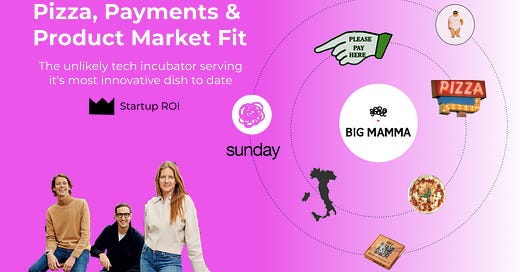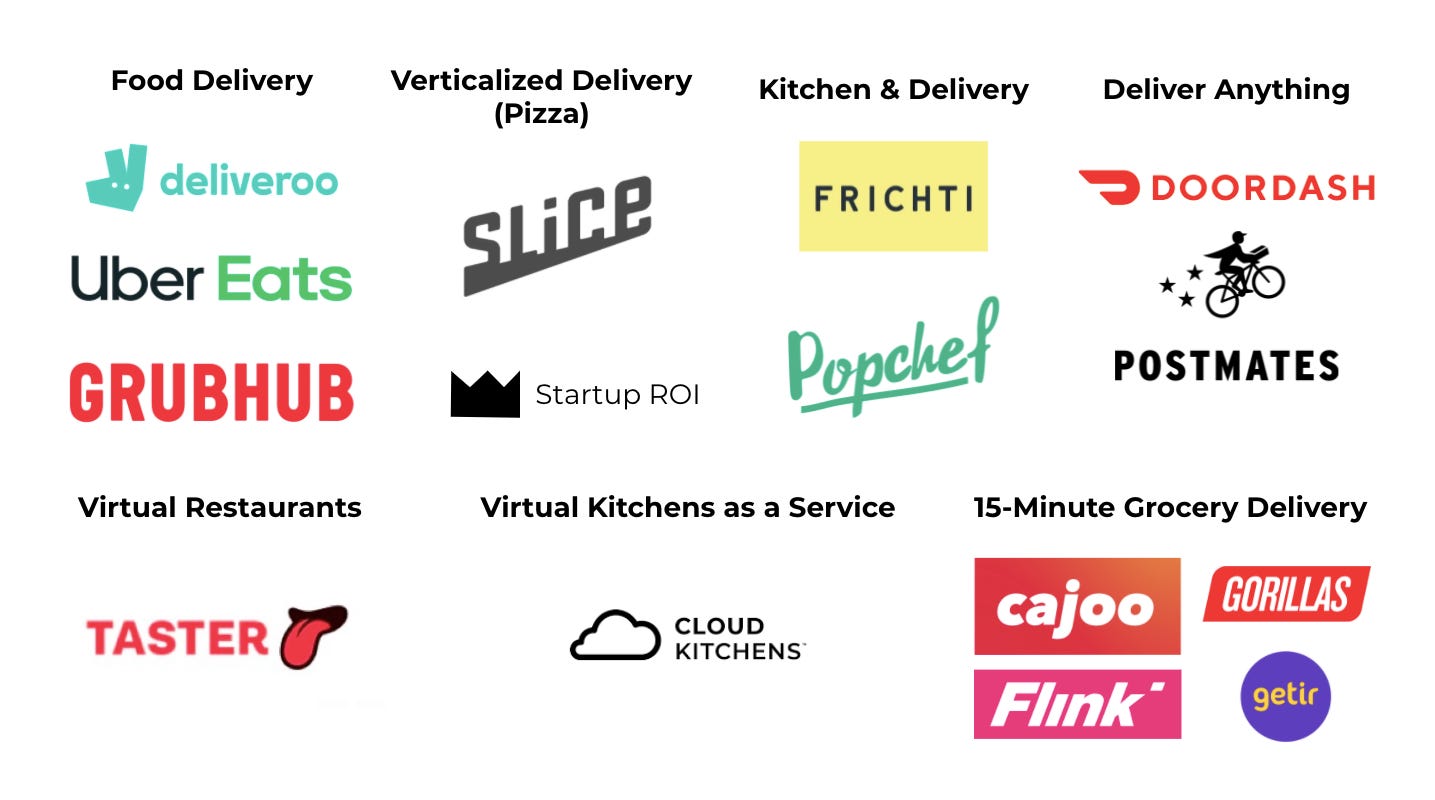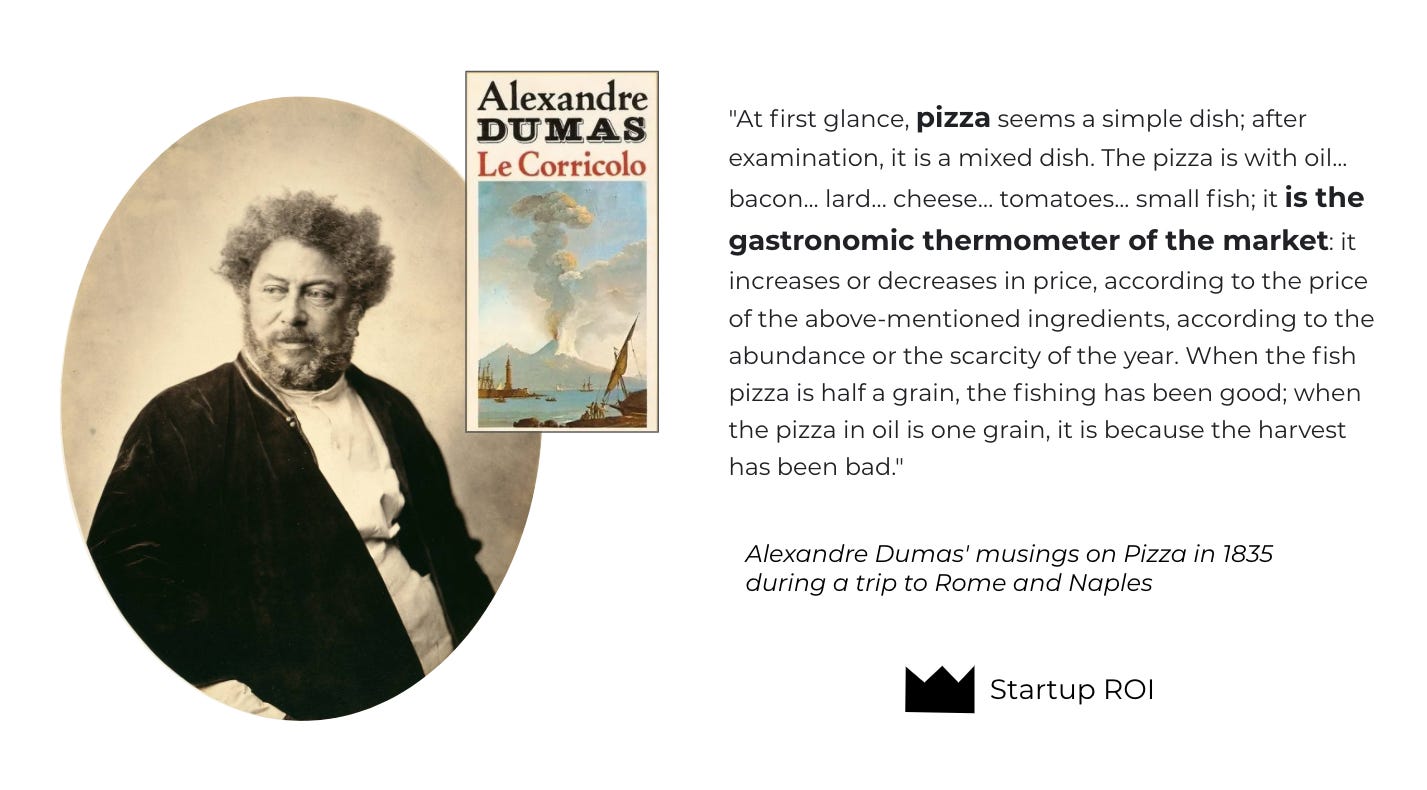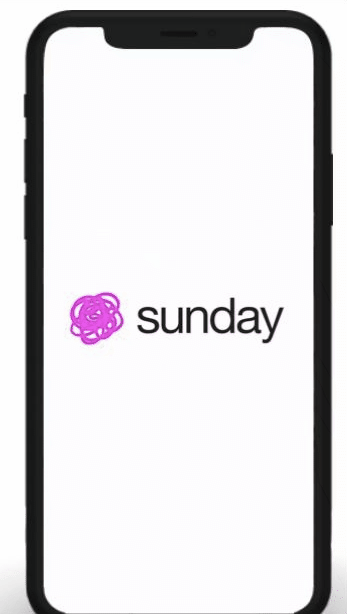🍕 Pizza, Payments & Product Market Fit
The unlikely tech incubator serving it's most innovative dish to date
Primi
The "Food Tech" and delivery scene is exploding. From grocery delivery to direct-to-consumer brands to agricultural systems powered by AI — the way we grow, harvest, market, pay for and consume food is changing with each new line of code. In most cases, this has been a textbook example of tech entering a "new frontier" — from digital to physical. In typical fashion, it's the tech outsiders working to drive adoption of their product in industries that are traditionally tech-phobic. But one company has emerged from the opposite direction: a payments app evolving out of a restaurant group. Today we'll explore Sunday, the newest and fastest way to pay the check at your favorite restaurants and why their organic approach to product development and design led to massive adoption and impressive international growth.
Delivery Wars & Cloud Kitchens
A Brief History of Pizza
Incubator with an Oven: Big Mamma Group
L’Addition SVP: Sunday App
Dessert, Anyone?
🔮 COMING UP: “Lockdowns and closures were a death sentence for many restaurateurs around the country, but in the fight for survival, Big Mamma spawned perhaps one of the biggest inventions in restaurant payments since the credit card itself: Sunday.”
Delivery Wars & Cloud Kitchens
Try as we might, we haven't figured out a way to write software that cures hunger. Until that's possible, tech companies are solving problems across every other point in the supply chain. Startups have helped optimize crop growth, stock grocery stores (Alkemics), produce alternative foods (Ynsect) and most recently figured out how to deliver anything you can imagine in under 15 minutes. Yes, I'm talking about the rapid grocery delivery spree that's been beaten to death in the media.
Sure, food is a central theme here. But from an operational standpoint, these are primarily infrastructure & logistics companies. How do we get meal A to point B using delivery driver C as fast as possible. Then of course, there's reconciling payments, routing, customer service etc. The services themselves don't make their own food. Originally, that is… Companies like Deliveroo have changed the way we discover food and have a distinct advantage over our "food graph" — what we like to eat, when, where we order it from, our spending habits… It's no wonder they got into the game themselves. It's a bit like Amazon realizing their sellers were making a killing and thinking: we could do that, let's mass produce the 100 most popular items and sell them cheaper + promote them to Prime users. In the delivery universe, the result has been dubbed "ghost kitchens."
You may have ordered from one without even knowing it. That's a testament to the creativity of the apps as well as just how disconnected we are from the food that we consume. The thought process behind ghost kitchens is simple: let's build a restaurant with no seating, no overhead and only a few menu items and sell exclusively through delivery apps. It's pretty clever. Your overhead is reduced dramatically: no servers, just a kitchen, some cooks and a few iPads to handle the incoming orders (all the software is powered by one of the aforementioned delivery apps). Perhaps no one has done this better than Taster. Taster has built 5 street food brands that have no physical presence and live both on local delivery apps and their own proprietary app. By focusing on one style of cuisine per brand (say, Thai or Burgers) they can pare down the menu and create highly-focused, top quality items. The brands are designed bottom up to be on delivery apps so the approach is tailor made in a sense to be marketing-first.


Peeling back one more layer and we get to Ghost Kitchens as a Service (GKaaS?). Travis Kalanick of Uber fame (remember him?) now has a stealth company called Cloud Kitchens that is slowly buying up retail kitchen properties so that any new virtual restaurant can spin up as easily as a developer taps into a new virtual machine on AWS. If this ghost kitchen trend takes off, the idea is genius. Even so, it does feel like some Black Mirror episode with warehouses full of chefs packed tightly like cattle so that some rich kid on the internet can get his favorite Vietnamese street food hand-fed to him in less than 15 minutes. Speed, quality & convenience are a deadly combination — but you have to admit, it sucks a little bit of the soul out of the dining experience.



In this dystopian foodscape, there is a singular force for good. And it's pizza. Before we move onto its illustrious history and universal appeal, I'd like to highlight one startup that is perhaps a corporeal counterpart to this ghostly world of translucent cuisine. It's called Slice. In essence, they've built the super app for mom & pop pizza shops. In technical terms, they've gone vertical (into pizza) enabling them to focus on a single customer base (pizza shops) and build meaningful solutions for that demographic. Instead of diluting quality with near unlimited choice, they've narrowed the scope and enhanced value for both the restaurants and the eaters. Today's story isn't about Slice or their history (they just raised a $42M Series C, read more here). But the fact that it even exists is proof of the power of pizza. You don't see a delivery app for exclusively Indian or Venezuelan cuisine (although, I'd def sign up!). It speaks to the universality of pizza, the complexity in its simplicity. Practically every culture has their own adaptation of pizza or already had some flatbread/cheese analog. Each style of pizza is unique, yet there's something for everyone. Which is exactly why the diversity of customers at a pizza shop is the perfect breeding ground for the next big innovation in restaurant tech.
A Brief History of Pizza
The first written account of pizza was in 997 A.D. in Gaeta, Italy about half way between Rome and Naples. Archeological and historical artifacts, however, indicate precursors to what we now call pizza dating back to antiquity:
In Sardinia, it was determined they baked bread up to 7000 years ago
In the 6th century B.C., battle shields from Darius the Great's army were adorned with paintings of baked flatbreads covered in dates and cheese
The Ancient Greeks had plakountos, a flatbread flavored with cheese and herbs
There's a reference in the Aneid to pita topped with vegetables
The real "innovation" in Pizza didn't occur until tomatoes were introduced to Europe in the 16th century. Originally thought to be poisonous like other fruits of the nightshade family, by the late 18th century peasants around Naples began incorporating them into their yeast-based flatbread. The Naples State Archive documented 54 known pizzerias in 1807. By the second half of the 19th century that number turned to 120. Not exactly exponential growth, but for the 1800s this had to be a notable trend!
This market made way for ancillary services in the pizza trade: pizzaiuolo ambulante — pizza hawkers, were basically Deliveroo drivers, just wayyyy ahead of their time. Back in the day, you had two classics: Pizza Marinara and Pizza Margherita. The former, named after (and usually prepared by) the "seaman's wife" contained tomato, oregano, garlic and extra virgin olive oil. The latter is rumored to have been selected as the favorite by Queen Margherita of Savoy in 1889 during a visit to Naples due to its ingredients representing the colors of the Italian flag (red = tomato sauce, white = mozzarella, green = basil). The globalization of pizza can be traced back to the Italian diaspora. In New York, for example, pizza was originally limited to the Italian immigrant population. But following World War II, soldiers exposed to Italian cuisine abroad became the base for a soon to be enormous market for pizza across the country.

As most readers will know, what came next was a rapid evolution (some might call Americanization) of pizza. Each major city developed its own signature style: Chicago deep dish, Detroit square pizza, St. Louis Thin crust — you name it. Fast food pizza chains emerged and we never looked back (although I'm not sure all varieties live up to the UNESCO Cultural Heritage definitions). But the US isn't the only country responsible for expanding pizza's footprint worldwide. Did you know that Hawaiian pizza is actually a Canadian invention (touchy subject, I know…). Even wilder is the fact that US pizza chains have exported their menus to countries all over the world and adapted ingredients to local tastes. The variety of flavor combinations is absolutely insane (and maybe even sacreligious to our old friends in Naples).
The ultimate point here? Pizza transcends cultural differences. It has a rich and respected history but like most great things has adapted to grow and survive in new territories. Pizza is a food but it's also a meme, a hometown point of pride, a dating profile tagline, and a food made for sharing and community. Which brings us to our "signature dish" (and the real reason for this article).
Incubator with an Oven: Big Mamma Group
If you're going out for Italian food in Paris, odds are you will land at one of Big Mamma Group's trattorias. Sprinkled across the city, the restaurant group has built a name for itself with high quality, highly stylized, authentic Italian cuisine. Their great food and Instagrammable venues attract lines out the door, success that has fueled international growth into Spain and the UK. One of their highest visibility projects, La Felicità, is an expansive food hall located in the heart of the French tech ecosystem at Station F.
If you look at their properties (physical or web) paired with the company's growth trajectory, you get the impression that it wasn't just built by a couple of friends who wanted to start a pizza joint. There is intention, design, culture and (to apply some tech lingo) scalability baked into their business model. Victor Lugger, the CEO and Co-Founder of Big Mamma, recently shared a bit of background on a podcast, where he delivers some insight into why that tech/software mindset played a role in developing a brick and mortar restaurant group.
The synopsis of his backstory is as follows: With his partner, Tigrane Seydoux, they tried to come up with the next big tech startup idea. But over 6-7 months they couldn't find anything they were truly passionate about. It should be said that previously, Victor was the Deputy CEO at MyMajor Company, a crowdfunding platform (like the Kickstarter of France) and Tigrane was involved in VC and private equity.
It's not uncommon to hear about someone leaving their more "conventional" industry gig to join a tech company seeking to disrupt it. But very rarely does it go the opposite way. I mean, I once met someone who left Silicon Valley for San Sebastian to start a microbrewery and escape the rat race, but his goal wasn't to build the next Heineken. Coming in at this angle, Victor and Tigrane could architect a restaurant experience from the ground up, supplemented by modern technology and their passion for great Italian food and culture. I'm certain it's the combination of forward-thinking and a level of authenticity that has contributed to their massive success. Incorporating vision, values, culture, hiring practices and scalable repeatable processes, they were able to replicate that success over and over again. Another key ingredient here (and the reason I dedicated a whole chapter to the history of pizza) is the cuisine. You see, pizza as it pertains to authenticity and market size, is the exception that proves the rule. I'm going to present two graphs to illustrate my point.
Chart 1: Typical Cuisine Curve

Chart 2: Pizza Curve has Normal Distribution

The first, is the typical curve when plotting Authenticity against Total Addressable Mouths (TAM); the second, is how this curve applies to pizza. We should probably define the axes first. If you don't get my TAM pun, then I'm not sure how you've tolerated all my previous articles. But it should be noted that TAM has many influencing factors: price, availability, convenience, and quality to name a few. For example, something could be Michelin starred but out of budget. That has an impact on the TAM.
Authenticity is a somewhat more nuanced definition, especially when it comes to pizza. I would argue that for most cuisines, authenticity is dependent on who is cooking the meal, the type/quality of ingredients, and the integrity of the recipe. With pizza, the definition may vary depending on how stringent your parameters are. Like, if you are the "Associazione Verace Pizza Napoletana" (True Neapolitan Pizza Association) it might limit authenticity to pizzas cooked in Naples with specific regional ingredients. But if you were born and bred in St. Louis, the most authentic pizza to you might be Imo's, a chain known for cracker thin slices and their (in)famous Provel cheese. Napoli purists favor simplicity and tradition, but deviations from the norm in either direction prove to increase TAM. Which is why I believe pizza adheres to a normal distribution (as pictured).
In contrast to the typical cuisine curve (pictured above) which is downward sloping to the right, the pizza curve has a "Sweet spot" right in the middle. It's here, departing from the local maximum to either side, where you achieve higher TAM without compromising too much on authenticity. In fact, it's exactly this kind of experimentation and innovation in pizza that has led to such a rich and diverse ecosystem of pizza styles. Of course you have your shitty, mass-produced chains on one side and obscure, hipster blasphemy on the other, but within that core is a veritable mix of delicious pies.
What's unique about Big Mamma Group is their ability to flatten the curve (yes, I said it) by bundling together all of the TAM factors without compromising on authenticity. They source high quality ingredients directly from Italy (check out their providers), they have a seasonal, reasonably priced menu, they've incorporated great design into the restaurants themselves. They even decided early on that all the waiters must speak Italian (as a 2nd language is OK too!) to ensure they have an appreciation and understanding of the culture. This is the kind of attention to detail that elevates a brand. But it's the innovation, organization and supporting technology that really sets them apart.
Remember our little chat about ghost kitchens? Big Mamma saw this as an opportunity to expand their business, not as an existential threat to their restaurants. In tech, we would consider this a distribution problem: how to get our product in the hands of your customers where and how they want it. So, they built their very own delivery/pick-up only front called Napoli Gang. They can effectively rinse and repeat their strategy from every other location, but this one is completely digital. So they built a new brand targeted at a younger, more online audience. The logistics are handled by a 3rd party app Uber Eats (which has a take rate), but effectively they can clone a version of their popular in-person dining experiences and digitize it with little to no overhead or supply chain changes. This is the type of thinking that fostered creativity in a time where resilience was at a premium. Lockdowns and closures were a death sentence for many restaurateurs around the country, but in the fight for survival, Big Mamma spawned perhaps one of the biggest inventions in restaurant payments since the credit card itself: Sunday.
L’Addition SVP: Sunday App
During the confinement period here in France, I started a tradition called "Pizza Tuesday." It was a way to keep spirits high, support local pizzerias and add a few kilos to my waistline — and it was well worth it. Each Tuesday, I ordered from a different pizzeria to build a small but critical database that I can share with friends and visitors. So if there is one qualm I have with Big Mamma's newest contribution to the restaurant industry, it's that they didn't call the app Tuesday.

The elevator pitch is simple: Sunday is the fastest way to pay at a restaurant. If you think about it, paying is the worst part of the dining experience. Not only do you have to part with your sweet, sweet cash, but more often than not you have to flag down your waiter (multiple times), double check the bill, do some mental math when splitting with friends… you get the gist. For the customer, it's inconvenient at worst, but for the wait staff it's truly the bane of their existence. They got into the service industry to talk about the specials and impress guests, not to race table to table with a bulky card terminal doing long division. With the re-introduction of QR codes into our lives (thanks, Covid-19!) Sunday has eliminated pain on both sides of the problem, creating a frictionless experience for customers and a boon to restaurants simultaneously. So, how does it work?
Step 1: Scan QR Code Located at Your Table
The QR Code serves as a running virtual tab for your table. Not only can you scan to see the menu (currently all the rage) but throughout your meal you can see the bill.
Step 2: Pay
You don't even have to login or create an account. You can use whatever card is synced up to your Apple/Google wallet or type in a physical card, cover the whole tab or select just the items that belong to you, and voila leave the table when you're done. Feels like dining and dashing!
Paying your bill at a restaurant is so integral to the experience that it's pretty wild to see what kind of impact it can have when it practically disappears. In Sales 101 you learn about the types of "pains" your prospective customer is experiencing so that you can provide meaningful solutions.
Level 1 Pain: Technical/Logistical
Level 2 Pain: Financial
Level 3 Pain: Emotional
For customers it's purely Level 1 pain: I'm late for my appointment and this g-ddamn waiter won't bring me the bill! But for waiters and restaurateurs alike, this goes deep, especially in the current climate. Things like "I can't turn over tables fast enough to keep up with demand" pale in comparison to "I have to lay off staff" or "I'm not sure I can keep the lights on next month if we don't find a solution." These are pretty compelling (and frankly heart-breaking) user stories . Sunday isn't a silver bullet for restaurant recovery, but the results they've found in their research are significant.

These four quick stats say it all. Get more customers, more tips (even in France where tipping is non-existent!), increase the amount purchased per customer (I guess I'll stay for that extra latte and dessert…). But the metric that impressed me most (and I'm biased towards user metrics) is the 80% adoption rate. In a world where app usage and retention is elusive, these are some impressive early numbers. Keep in mind, this means that Sunday onboarded a restaurant who then put QR codes on their table and 80% of the customers from there on out successfully paid their bill with the app. Think about the number of user steps that have to go seamlessly to prevent someone giving up and calling the waiter over. This is a feat of UX design if I've ever seen one. Which brings me to my last point. This app could only be "born" in a restaurant.

It's not every day that a restaurant gives birth to a software platform. The only example I can think of is Domino's creating their own order & delivery app, but they kept it proprietary. The closest analogy I can come up with is Amazon building AWS in-house and then spinning out an entirely new business that is extremely profitable and widely adopted. We're on different orders of magnitude here but you get the point. Most of the tech attempting to disrupt the restaurant space is doing so with an outsider's point of view. Which is what makes Sunday stand out in an overcrowded space. In some ways, it's a similar story to many great startup journeys. You encounter a problem, you find a solution, you productize & scale that solution and sell it to customers. Each step of the way, however, Sunday had Big Mamma Group as their "test kitchen" to conduct research, collect feedback, and iterate to near perfection. It's an app designers dream: a constant UX feedback loop and real-world personas to boot. In solving their own problem, they found a path to solving one of the challenges that every other restaurateur in the world is facing today. And in doing so, they have redefined the dining experience. It appears their product market fit is already proven. It's no wonder they raised a €21.8M seed round.
Dessert, Anyone?
At such an early stage, they are planning to launch internationally in Spain, the UK & the US. Early indications show tremendous promise but there are no doubt obstacles in sight. Cultural differences may play a role in how users adopt the app or restaurateurs see value. In the US, for example, tipping 15-20% is standard practice. Can we be certain that the increased tip conversion isn't limited to countries accustomed to zero gratuity? There will surely be competition ranging from existing payment processors, point of sales systems and the like. But if anything, I think this lays the groundwork for the next chapter of restaurants. If there is so much value this early, imagine what we can expect restaurants to do with that extra time & money. For now, all I know is that I'll be less hesitant ordering that dessert when I'm in a rush.
If this subject interests you, I highly recommend listening to Land of the Giants: Delivery Wars ⤵️
If you want an elevator pitch on Sunday, check out Victor Lugger's interview on Good Morning Business (en Français):












